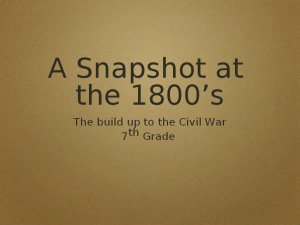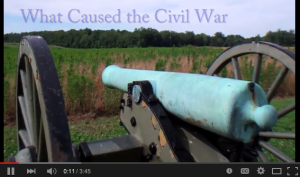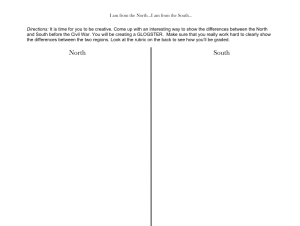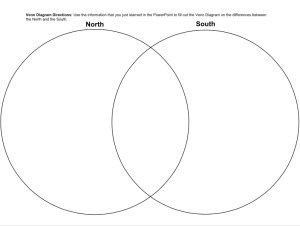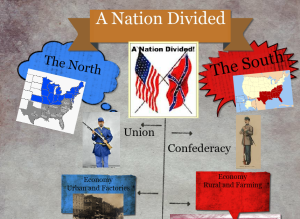Unit Goal
The student will explain the causes, major events, and consequences of the Civil War. How did the differences between the North and South create conflict and war between the two regions?
Unit Objective
-
Given skeletal notes Students will complete student notes based on the PowerPoint presentation with 100% accuracy;
-
Given a venn diagram students will compare and contrast the social, cultural, and geographic differences of the North vs. the South with 80% accuracy;
-
Students will complete a worksheet in written form called I am from the South, I am from the North. Students will write five facts about the South and 5 facts about the North with 80% accuracy; and
-
Student will categorize and organize facts and information to show the differences between the North and the South using Glogster using a rubric with 80% accuracy.
Background and Rationale
This particular lesson is the first of a six-lesson unit from BetterLessons.com The unit explores the causes, events, and consequences of the American Civil War. The unit begins with the lesson a Nation Divided that lays the groundwork for a discussion about the outbreak of the war by looking at the economic, geographic, and cultural differences between the North and South during the 1800. Based on this particular 7th grade a majority of the students are beginning English Language Learners and Special Education. The reading material has been simplified to a 5th grade level to challenge but not confuse them. *Students with disabilities in this class will need various modifications such as simplified text, visuals with vocabulary, and guided prompting. This particular lesson is comprised of skeletal guided notes, graphic organizers and visuals to differentiate instruction to meet the diverse needs of all learners.
Lesson Objectives
Objective |
Bloom’s Verb |
|---|---|
|
Students will compare and contrast the social, cultural, and geographic differences between the North and South before the Civil War |
Analyzing |
|
Students will complete a guided notes based on the PowerPoint presentation |
Remembering |
|
Students will complete a Venn diagram comparing and contrasting the North vs. the South; |
Remembering |
|
Students’ will complete a worksheet called I am from the South, I am from the North. Students will write five facts about the South and 5 facts about the North |
Analyzing |
| Student will categorize and organize facts and information | Creating |
Bloom’s Taxonomy
Creating (Bloom’s highest level)
Curriculum Standards
Standard 1: History of the United States and New York
Students will use a variety of intellectual skills to demonstrate their understanding of major ideas, eras, themes, developments, and turning points in the history of the United States and New York.
Standard 3: Geography
Students will use a variety of intellectual skills to demonstrate their understanding of the geography of the interdependent world in which we live—local, national, and global—including the distribution of people, places, and environments over Earth’s surface.
Standard 4: Economics
Students will use a variety of intellectual skills to demonstrate their understanding of how the United States and other societies develop economic systems and associated institutions to allocate scarce resources, how major decision-making units function in the United States and other national economies, and how an economy solves the scarcity problem through market and nonmarket mechanisms.
Standard 5: Civics, Citizenship, and Government
Students will use a variety of intellectual skills to demonstrate their understanding of the necessity for establishing governments; the governmental systems of the United States and other nations; the United States Constitution; the basic civic values of American constitutional democracy; and the roles, rights, and responsibilities of citizenship, including avenues of participation.
The National Council for the Social Studies (NCSS)
The National Council for the Social Studies (NCSS) has developed national standards to provide guidelines for teaching social studies.
This lesson plan addresses the following thematic standards:
-
Time, Continuity, and Change
-
Individuals, Groups, and Institutions
-
Power, Authority, and Governance
-
Production, Distribution, and Consumption
Learning and Innovation Skills (P21.org)
Think Creatively
-
Use a wide range of idea creation techniques (such as brainstorming)
-
Create new and worthwhile ideas (both incremental and radical concepts)
-
Elaborate, refine, analyze and evaluate their own ideas in order to improve and maximize creative efforts
Life and Career Skills (P21.org)
Manage Goals and Time
-
Set goals with tangible and intangible success criteria
Be Self-directed Learners
-
Go beyond basic mastery of skills and/or curriculum to explore and expand one’s own learning and opportunities to gain expertise
Information, Media, and Technology Skills (P21.org)
Access and Evaluate Information
-
Access information efficiently (time) and effectively (sources)
-
Evaluate information critically and competently
Create Media Products
-
Understand and utilize the most appropriate media creation tools, characteristics and conventions
Apply Technology Effectively
-
Use technology as a tool to research, organize, evaluate and communicate information
Lesson – Introduction
Using the think-pair-share strategy have students list at least three reasons for the Civil Wars on a piece of paper or mini dry erase boards. Partner the students and have them share their reasons with each other. Bring students together and compile reasons on chart paper or chalkboard. Discuss patterns that exist. Then explain the first step in studying the Civil War is to figure out the reasons that the war started. Students will demonstrate knowledge of the issues that divided the nation and led to the Civil War. This lesson will focus on the cultural, economic, and constitutional issues that divided the nation. (5 min)
Key Vocabulary Terms
abolitionist
Definition: Person who worked to end slavery during the 18th and 19th centuries
Context: Abolitionist John Brown had a bold plan to strike against slavery.
Confederate states
Definition: Southern states that that seceded from the U.S. to form their own nation, the Confederate States of America
Context: Lincoln’s push to end slavery angered the Confederate states.
Dred Scott Decision
Definition: Supreme Court decision that stated Congress had no power to ban slavery anywhere, including the territories
Context: While the fighting went on in Kansas, the Supreme Court issued the controversial Dred Scott Decision, named after a slave.
Emancipation Proclamation
Definition: An edict issued by President Lincoln on January 1, 1863, making slavery illegal in the Confederate states
Context: The Emancipation Proclamation made slavery illegal in the 11 rebelling Southern states, but it left slavery in place in the states that had stayed loyal to the Union.
Fugitive Slave Act
Definition: A law passed by Congress in 1850 that required the return of runaway slaves
Context: Northerners protested the Fugitive Slave Act.
Kansas-Nebraska Act
Definition: A law passed in 1854 that allowed the majority of settlers in each territory to decide whether or not they would allow slavery in the area
Context: Illinois Senator Stephen Douglas proposed the Kansas-Nebraska Act.
popular sovereignty
Definition: The pre-Civil War doctrine asserting that settlers within each territory should decide whether or not to allow slavery
Context: The Kansas-Nebraska Act proposed the idea of popular sovereignty.
secede
Definition: To withdraw from the nation
Context: In late 1860 and early 1861, seven Southern states seceded from the United States and formed the Confederate States of America.
Union states
Definition: Northern states that remained loyal to the federal government during the Civil War
Context: President Abraham Lincoln asked Union states to send troops to put down the rebellion in the Confederate states.
Lesson Activities and Procedures
(45 minutes)
Student Procedure |
Teacher Procedure |
Materials |
|---|---|---|
|
Students will be presented with a PowerPoint entitled – “A Snapshot at America in the Mid 1800’s” |
The teacher will explain that wars don’t just happen out of nowhere – there are certain reasons that conflicts start.
|
|
|
Students will define the meaning of idioms and understand the difference between figurative and literal language by completing a graphic organizer T-Chart to form a deeper understanding of idioms. |
The teacher will go through each slide in the PowerPoint. The PowerPoint will be focused on the Northern Region (their economy, culture, and geography), the Southern Region (their economy, culture, and geography).
|
Powerpoint: Powerpoint |
|
The students will answer the questions on their graphic organizers. |
After each slide, The teacher will help prompt the students to answer the questions on their graphic organizers.
|
|
|
After completing the notes students will play game on the PowerPoint involving the stories about people from different regions of the antebellum U.S. to reinforce key points of the lecture. |
The teacher will use the activity as an informal check of understanding on the main concepts of the lesson. |
|
| The students will receive help with the guided practice answering the key points as needed. |
The teacher will pull those students that look to be struggling after the guided practice to review some of the key points.
|
|
|
Student will view a short video clip that summarizes the causes of tension between the north and south. (5 minutes) |
After viewing the video students will be asked to complete a exist card to identify two causes of the the Civil War. (5 minutes)
|
Civil War Movie (5 minutes ) |
| Day 2 (1 hour) |
Day 2 | Day 2 |
| Bell work: students will write in their journals the causes of the civil. This will review the previous day’s material to reinforce key concepts. A class discussion will be held and questions will be addressed based on the previous day’s exit card. | The teacher will ask the students to complete the bell work for review of the previous day’s lesson. | |
|
Students will be ask to complete a Venn diagram with “North” labeled over one circle, and “South” labeled over the other circle. |
The teacher will hand out the worksheet: “I am from the North… I am from the South…” and The teacher will explain that a Venn diagram compares and contrasts two different things. The information in the outer part of the circle shows how the two things are different. The information in both of the circles shows how they are the same. | |
| The students will use their notes for the Venn Diagram and as well as their handout to compare and contrast the North and South prior to the Civil War |
The teacher will instruct the students that they can use their notes to fill out the Venn diagram comparing the North and South prior to the Civil War. |
Student Skeletal Notes |
|
Students will be given explicit directions of their Glogster project. *see assessment. |
The teacher will go over the rubric included with the worksheet to make sure everyone understands the objective and expectations of the assignment. After completing both handouts |
Lesson Closure
Students will close the lesson by completing the I just to think…..but now I know thinking routine on a class blog. (10 minutes)
I Use to Think….. But Now I think
The purpose of this activity is to help students reflect on their thinking about the topic and to identify how their ideas have changed over time. Students will complete this routine on a class blog.
When we began this study of Civil War, you all had some initial ideas about it and what it was all about. In just a few sentences, I want to write what it is that you used to think about the Civil War. Take a minute to think back and type your responses in the class blog “ I used to think…”
Now, I want you to think about how your idea about the Civil War have changed as a result of what we’ve been studying/doing/discussing. Again in just a few sentences write down what you now think about the Civil War. Start your sentences with, “But now, I think…”
Assessment
At the end of the lesson, students will have to complete a Venn diagram comparing the North and the South. In addition, the students will fill out a worksheet entitled, “I am from the North. I am from the South…” This worksheet will assess what the students learned from the lesson. The teacher will collect the Venn diagrams, and worksheet, to use as a formative assessment to monitor student progress. Student’s final product will be creating a Glogster of the differences between the North and South before the Civil War. (See Rubric)
|
4 (Exceeding Expectations) |
It is evident that the student went above and beyond to come up with a creative way to display the differences between the North and South before the Civil War. The student combined both images and writing in their Glogster . |
The student went above and beyond to provide facts about both the North and South before the Civil War. There is at least four facts about each region. |
|
3 (Meeting Expectations) |
The student displayed the differences between the North and South before the Civil War in a creative way by incorporating images and 4 facts in their Glogster.
|
The student did a good job providing facts about both the North and South before the Civil War. There is a total of three facts about each region. |
|
2 (Not Meeting Expectation) |
The student attempted to display the differences between the North and South before the Civil War, but either did not complete his/her work, or did not show a lot of effort because the work did not have that many images or writing in their Glogster. |
The student did not provide enough facts about either the North or South before the Civil War. There is a total of one to two facts about each region. |
|
1 (Not Evident) |
The student did not attempt to complete the assignment. There is no creativity or effort shown on this assignment. |
The student did not attempt to complete the assignment. There is no accurate content on the sheet. |
References: Ritchhart, R., Church, M., & Morrison, K. (2011). Making Thinking Visible: How to Promote Engagement, Understanding, and Independence for All Learners. San Francisco, CA: Jossey-Bass. Civil War. Retrieved June 24, 2014, from http://www.bestterlessons.com

